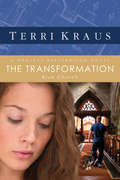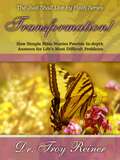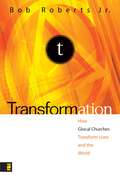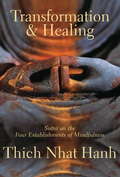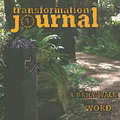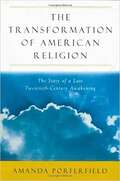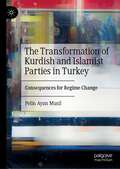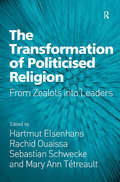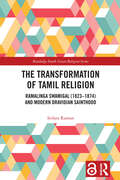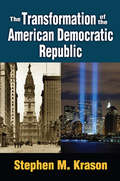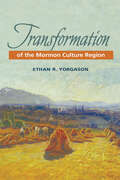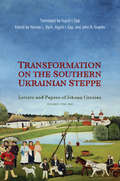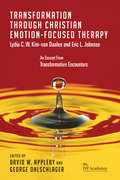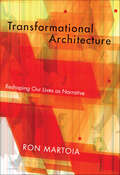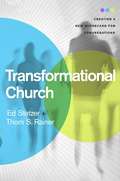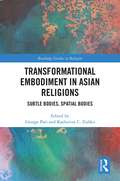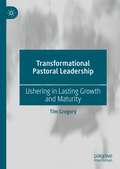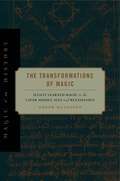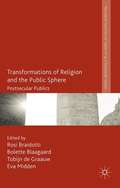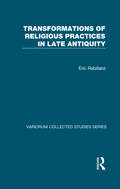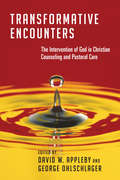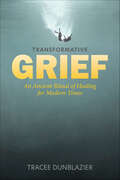- Table View
- List View
The Transformation
by Terri KrausCan a good, hard-working Christian man disregard his cultural and religious admonitions--as well as his mother's plans for his life--for the love of a woman and an historic church building?Oliver Barnett is a good contractor, a good Christian, and an obedient son, never in trouble, never one to rock the boat ... until real estate developer Samantha Cohen enters his life. Samantha, full of life, vitality, and wit, is unlike any woman he has ever known--in more ways than one. Not only is she planning to transform an historic church near downtown Pittsburgh into a restaurant/nightclub, but she is Jewish and has a less-than-innocent past. Oliver finds himself in a most unsettling dilemma. Does he do what's right by the nice girl his mother has chosen for him, or does he do what his heart is telling him to do?
Transformation!: How Simple Bible Stories Provide In-Depth Answers for Life's Most Difficult Problems
by Troy ReinerOur society and churches are facing an increasing number of dysfunctional and emotionally hurting people with difficult, long-term psychological problems. Healing for these problems requires more than a few words of advice or some solution-focused therapy; it requires a life transformation. Unfortunately, most pastors and church counselors do not have in-depth Biblical answers for these complex problems. Consequently, most churches refer these problems to counselors outside of the church who rely primarily on secular counseling methods and theories, or psychoactive drugs. What is needed is a simple, yet in-depth, Biblical method for overcoming these complex problems that can be easily applied by pastors and counselors within the church. <p><p>This book provides just such a method with a new narrative Biblical approach for therapy and in-depth answers for counseling many of these difficult problems. This new method is developed directly from the Bible, relies on the overall direction of the Holy Spirit, and is based on Biblical truth derived from the stories of the lives of well-known Biblical characters. The final conclusion of this book is that God has provided in His word, through the types and shadows interpretation of these stories, all that is required to meet these desperate needs. <p><p>This book contains many new insights including a comprehensive plan for Christian counseling derived directly from the Bible, in-depth biblical answers for complex psychological problems based on the types and shadows interpretation of biblical stories, models and quick reference guides for counseling 20 of the most difficult problems in the church today including inferiority, abandonment, dysfunctional families, setting boundaries, six types of codependency, abuse, four types of addictions, bitterness, depression, grief, and suicide.
Transformation: Discipleship that Turns Lives, Churches, and the World Upside Down (Exponential Series)
by Bob Roberts JR.Author and pastor Bob Roberts Jr. is one of the architects of what church and Christian community can become in this new century. His unique approach to Christianity is based on what he calls T-Life (transformed life), which leads to a T-World (transformed world). Drawing inspiration from early church history and the emerging church in the developing world, Roberts envisions a new way of engaging the local church to achieve common goals. He calls for building a church culture rather than a church program. Glocal churches create disciples who, transformed by the Holy Spirit, are infiltrating today’s culture on a global and local scale. In Roberts’s terms, when we establish a relationship with Jesus Christ and begin applying his principles, we experience T-Life (transformed life). Transformation begins with a growing, interactive relationship with God that includes personal and corporate worship. This, in turn, results in community. As community serves others, transformation has both a global and local (glocal) impact and creates T-World. Transformation redefines the focus and practice of the church, not from external bells and whistles, but from the internal transformation of the very character of its people.
Transformation and Healing
by Thich Nhat HanhThe Sutra has been studied, practiced, and handed down with special care from generation to generation for 2,500 years. In these commentaries, Thich Nhat Hanh guides the reader to an understanding of the fundamental basis of the Buddhist practice and encourages application in daily life. The book describes the four methods of mindfulness: mindfulness of the body, the feelings, the mind, and the object of mind. It teaches how to deal with anger and jealousy; to nurture the best qualities in our children, spouse, and friends; and to greet death with compassion and equanimity. Three versions of the Sutra on the Four Establishments of Mindfulness are presented here, along with Thich Nhat Hanh's insightful commentary, his discussion of breathing techniques, and 23 exercises - or contemplations - to aid in the daily practice of mindfulness. Accessible to novice Buddhists as well as more advanced practitioners, this second edition features a new introduction by the author.
Transformation Journal: A Daily Walk in the Word
by Carolyn Slaughter Sue Nilson KibbeyEveryone is looking for a spiritual discipline that is both relevant to daily life and easy to stick with. Transformation Journal meets this need and more, offering users daily Bible studies and insightful questions that invite reflection and response. Each week highlights a different biblical topic, using brief introductions and a variety of scriptures to give the user a glimpse into what the Bible has to say on each theme. Guiding questions to help users reflect on the experiences and observations of biblical figures and apply the scriptures to their own lives.
The Transformation of a Religious Landscape: Medieval Southern Italy, 850–1150
by Valerie RamseyerThe Transformation of a Religious Landscape paints a detailed picture of the sheer variety of early medieval Christian practice and organization, as well as the diverse modes in which church reform manifested itself in the eleventh and twelfth centuries. From the rich archives of the abbey of the Holy Trinity of Cava, Valerie Ramseyer reconstructed the complex religious history of southern Italy. No single religious or political figure claimed authority in the region before the eleventh century, and pastoral care was provided by a wide variety of small religious houses. The line between the secular and the regular clergy was not well pronounced, nor was the boundary between the clergy and the laity or between eastern and western religious practices. In the second half of the eleventh century, however, the archbishop of Salerno and the powerful abbey of Cava acted to transform the situation. Centralized and hierarchical ecclesiastical structures took shape, and an effort was made to standardize religious practices along the lines espoused by reform popes such as Leo IX and Gregory VII. Yet prelates in southern Italy did not accept all aspects of the reform program emanating from centers such as Rome and Cluny, and the region's religious life continued to differ in many respects from that in Francia: priests continued to marry and have children, laypeople to found and administer churches, and Greek clerics and religious practices to coexist with those sanctioned by Rome.
The Transformation of American Religion: The Story of a Late-Twentieth-Century Awakening
by Amanda PorterfieldAs recently as a few decades ago, most people would have described America as a predominantly Protestant nation. Today, we are home to a colorful mix of religious faiths and practices, from a resurgent Catholic Church and a rapidly growing Islam to all forms of Buddhism and many other non-Christian religions. How did this startling transformation take place? <p><p> A great many factors contributed to this transformation, writes Amanda Porterfield in this engaging look at religion in contemporary America. Religious activism, disillusionment with American culture stemming from the Vietnam war, the influx of Buddhist ideas, a heightened consciousness of gender, and the vastly broadened awareness of non-Christian religions arising from the growth of religious studies programs--all have served to undermine Protestant hegemony in the United States. But the single most important factor, says Porterfield, was the very success of Protestant ways of thinking: emphasis on the individual's relationship with God, tension between spiritual life and religious institutions, egalitarian ideas about spiritual life, and belief in the practical benefits of spirituality. <p><p> Distrust of religious institutions, for instance, helped fuel a religious counterculture--the tendency to define spiritual truth against the dangers or inadequacies of the surrounding culture--and Protestantism's pragmatic view of spirituality played into the tendency to see the main function of religion as therapeutic. For anyone interested in how and why the American religious landscape has been so dramatically altered in the last forty years, The Transformation of Religion in America offers a coherent and persuasive analysis.
The Transformation of Kurdish and Islamist Parties in Turkey: Consequences for Regime Change
by Pelin Ayan MusilThis book analyzes the transformation of ethnic and religious political parties in Turkey with special focus on their role in the country’s democratization and regime changes. Turkey went through a process of autocratization under the rule of the AKP government over the last two decades. Scholars question the structural, agent-centered and cultural factors that led the country on this path, and provide the lessons learnt from this case for other cases of democratic decline or breakdown. This book contributes to this debate. It treats the three national elections (2002, 2007, 2015-June) as opportunities for democratization, in which the Islamist-successor AKP (in 2002, 2007) and the Kurdish-successor HDP (in 2015-June) managed to overcome identity politics and received the organized support from social groups outside of their traditional constituency. This book argues that in a semi-democratic context where repressive acts of the state (e.g. banning of parties, arresting politicians) have been subject to widespread public criticism, confronting the state becomes a salient issue. When these parties manage to frame this issue as one of democracy, they take ownership of it, and this then becomes an opportunity for democratizing the regime. This opportunity, yet, can be missed if the party follows an office-seeking strategy rather than a policy-seeking one.
The Transformation of Politicised Religion: From Zealots into Leaders
by Rachid Ouaissa Hartmut Elsenhans Mary Ann TétreaultIncluding contributions from leading scholars from Algeria, France, Germany, India and the United States this book traces the rise and turn to moderation of the New Cultural Identitarian Political Movements, often labelled in the West as fundamentalists. Arguing that culturally based ideologies are often the instruments, rather than the motivating force though which segments of a rising middle strata challenge entrenched elites the expert contributors trace the rise of these movements to changes in their respective countries’ political economy and class structures. This approach explains why, as a result of an ongoing contestation and recreation of bourgeois values, the more powerful of these movements then tend towards moderation. As Western countries realise the need to engage with the more moderate wings of fundamentalist political groups their rationale and aims become of increasing importance and so academics, decision-makers and business people interested in South Asia and the Muslim world will find this an invaluable account.
The Transformation of Tamil Religion: Ramalinga Swamigal (1823–1874) and Modern Dravidian Sainthood (Routledge South Asian Religion Series)
by Srilata RamanThis book analyses the religious ideology of a Tamil reformer and saint, Ramalinga Swamigal of the 19th century and his posthumous reception in the Tamil country and sheds light on the transformation of Tamil religion that both his works and the understanding of him brought about. The book traces the hagiographical and biographical process by which Ramalinga Swamigal is shifted from being considered an exemplary poet-saint of the Tamil Śaivite bhakti tradition to a Dravidian nationalist social reformer. Taking as a starting point Ramalinga’s own writing, the book presents him as inhabiting a border zone between early modernity and modernity, between Hinduism and Christianity, between colonialism and regional nationalism, highlighting the influence of his teachings on politics, particularly within Dravidian cultural and political nationalism. Simultaneously, the book considers the implication of such an hagiographical process for the transformation of Tamil religion in the period between the 19th –mid-20th centuries. The author demonstrates that Ramalinga Swamigal’s ideology of compassion, cīvakāruṇyam, had not only a long genealogy in pre-modern Tamil Śaivism but also that it functioned as a potentially emancipatory ethics of salvation and caste critique not just for him but also for other Tamil and Dalit intellectuals of the 19th century. This book is a path-breaking study that also traces the common grounds between the religious visions of two of the most prominent subaltern figures of Tamil modernity – Iyothee Thass and Ramalingar. It argues that these transformations are one meaningful way for a religious tradition to cope with and come to terms with the implications of historicization and the demands of colonial modernity. It is, therefore, a valuable contribution to the field of religion, South Asian history and literature and Subaltern studies. The Open Access version of this book, available at http://www.taylorfrancis.com/books/e/9781315794518 has been made available under a Creative Commons Attribution-Non Commercial-No Derivatives 4.0 license.
The Transformation of the American Democratic Republic
by Stephen M. KrasonIn this stimulating volume, Stephen M. Krason considers whether the Founding Fathers' vision of the American democratic republic has been transformed and if so, in what ways. He looks to the basic principles of the Founding Fathers, then discusses the changes that resulted from evolving contemporary expectations about government. Referencing philosophical principles and the work of great Western thinkers, Krason then explores a variety of proposals that could forge a foundation for restoration.Acknowledging that any attempt to revive the Founders' views on a democratic republic must start in the public sphere, Krason focuses on concerned citizens who are aware of the extent to which our current political structures deviate from the Founders' vision and want to take action. Ultimately, a democratic republic can exist, be sustained, and flourish only when there is a deep commitment to it in the minds and norms of its people.Written by a foremost authority in the field of US Constitutional law, this book will appeal to those interested in American history, society, and politics.
The Transformation of the American Democratic Republic
by Stephen M. KrasonIn this stimulating volume, Stephen M. Krason considers whether the Founding Fathers' vision of the American democratic republic has been transformed and if so, in what ways. He looks to the basic principles of the Founding Fathers, then discusses the changes that resulted from evolving contemporary expectations about government. Referencing philosophical principles and the work of great Western thinkers, Krason then explores a variety of proposals that could forge a foundation for restoration.Acknowledging that any attempt to revive the Founders' views on a democratic republic must start in the public sphere, Krason focuses on concerned citizens who are aware of the extent to which our current political structures deviate from the Founders' vision and want to take action. Ultimately, a democratic republic can exist, be sustained, and flourish only when there is a deep commitment to it in the minds and norms of its people.Written by a foremost authority in the field of US Constitutional law, this book will appeal to those interested in American history, society, and politics.
Transformation of the Mormon Culture Region
by Ethan YorgasonIn this unique study, Ethan R. Yorgason examines the Mormon "culture region" of the American West, which in the late nineteenth century was characterized by sexual immorality, communalism, and anti-Americanism but is now marked by social conservatism. Foregrounding the concept of region, Yorgason traces the conformist-conservative trajectory that arose from intense moral and ideological clashes between Mormons and non-Mormons from 1880 to 1920. Looking through the lenses of regional geography, history, and cultural studies, Yorgason investigates shifting moral orders relating to gender authority, economic responsibility, and national loyalty, community, and home life. Transformation of the Mormon Culture Region charts how Mormons and non-Mormons resolved their cultural contradictions over time by a progressive narrowing of the range of moral positions on gender (in favor of Victorian gender relations), the economy (in favor of individual economics), and the nation (identifying with national power and might). Mormons and non-Mormons together constructed a regime of effective coexistence while retaining regional distinctiveness.
Transformation on the Southern Ukrainian Steppe: Letters and Papers of Johann Cornies, Volume II: 1836–1842 (Tsarist and Soviet Mennonite Studies)
by Ingrid I. EppIn the eighteenth and nineteenth centuries, the Russian empire opened the grasslands of southern Ukraine to agricultural settlement. Among the immigrants who arrived were communities of Prussian Mennonites, recruited as "model colonists" to bring progressive agricultural methods to the east. Transformation on the Southern Ukrainian Steppe documents the Tsarist Mennonite experience through the papers of Johann Cornies (1789–1848), an ambitious and energetic leader of the Mennonite colony of Molochna. Cornies was well connected in the imperial government, and his papers offer a window not just into the world of the Molochna Mennonites, but also into the Tsarist state’s relationship with the national minorities of the frontier: Mennonites, Doukhobors, Nogai Tatars, and Jews. This selection of his letters and reports, translated into English, is an invaluable resource for scholars of all aspects of life in Tsarist Ukraine and for those interested in Mennonite history.
Transformation Through Christian Emotion-Focused Therapy: Chapter 10, Transformative Encounters
by Eric L. Johnson Lydia C. DaalenTransformative Encounters,The Rebuilding of Psychology
Transformational Architecture: Reshaping Our Lives as Narrative
by Ron Martoia&“How Can I More Effectively Reach People of My Generation with the Message of the Gospel?&” Start the story where God starts the story. In other words, it&’s not about &“lifestyle evangelism.&” Or being cleverer than the person with whom you&’re talking. Or knowing everything there is to know about the Bible. It&’s about knowing what&’s most important to your friends, family, coworkers, and others you meet along life&’s journey. It&’s about, to use author Ron Martoia&’s words, discovering the &“story&” each of us lives every waking day of our lives. Once you know that, you&’ll know how God&’s story fits into our human stories. Jesus spread the Good News this way. He talked to people, asked them questions about who they were, what they were doing–in short, he found out what made each person get out of bed every morning. And then he shared with them a bigger story–and how they fit into it. Jesus knew that when people grasped God&’s big picture, they felt compelled–even overjoyed–to be a part of it. In today&’s increasingly individualistic, disenfranchised world, it&’s never been more important to know God&’s story and how one fits into it. Let Transformational Architecture be your guide to reaching those around you with God&’s life-changing message of hope.
Transformational Church: Creating a New Scorecard for Congregations
by Thom S. Rainer Ed StetzerHow are we doing? The church, that is. And how are we doing it? Congregations have long measured success by "bodies, budget, and buildings"--a certain record of attendance, the offering plate, and square footage. But the scorecard can't stop there. When it does, the deeper emphasis on accountability, discipleship, and spiritual maturity is lost. Ignoring those details, we see fewer lives transformed, Christian influence wane, and churches thin out--a situation that is all too familiar across North America today. It is time to take heart and rework the scorecard. According to Ed Stetzer and Thom S. Rainer, the authors of Transformational Church, "Too often we've highlighted the negative realities of the declining American church but missed the opportunity to magnify the God of hope and transformation. " Based on the most comprehensive study of its kind, including a survey of more than 7,000 churches and hundreds of on-site interviews with pastors, Transformational Church takes us to the thriving congregations where truly changing lives is the norm. Stetzer and Rainer clearly confirm the importance of disciple making for all through active biblical engagement and prayerful dependence on God alongside of ever-increasing, intentional participation in mission and ministry activities. As the church engages these issues, the world will see the change: * More people following Christ * More believers growing in their faith * More churches making an impact on their communities The transformation starts now.
Transformational Embodiment in Asian Religions: Subtle Bodies, Spatial Bodies (Routledge Studies in Religion)
by George Pati Katherine ZubkoThis volume examines several theoretical concerns of embodiment in the context of Asian religious practice. Looking at both subtle and spatial bodies, it explores how both types of embodiment are engaged as sites for transformation, transaction and transgression. Collectively bridging ancient and modern conceptualizations of embodiment in religious practice, the book offers a complex mapping of how body is defined. It revisits more traditional, mystical religious systems, including Hindu Tantra and Yoga, Tibetan Buddhism, Bon, Chinese Daoism and Persian Sufism and distinctively juxtaposes these inquiries alongside analyses of racial, gendered, and colonized bodies. Such a multifaceted subject requires a diverse approach, and so perspectives from phenomenology and neuroscience as well as critical race theory and feminist theology are utilised to create more precise analytical tools for the scholarly engagement of embodied religious epistemologies. This a nuanced and interdisciplinary exploration of the myriad issues around bodies within religion. As such it will be a key resource for any scholar of Religious Studies, Asian Studies, Anthropology, Sociology, Philosophy, and Gender Studies.
Transformational Pastoral Leadership: Ushering in Lasting Growth and Maturity
by Tim GregoryThis book provides a model, based on Paul’s letter to the church in Philippi, to help pastors lead in a manner that brings lasting change and maturity to congregational members. The project addresses the need for pastors to move beyond a transactional mindset to a transformational approach to leadership, and it provides a model for them to follow. Tim Gregory grounds the call to transformational leadership in a close reading of Paul, drawing out multiple dimensions of what that leadership should strive to develop in a faith community.
The Transformations of Magic: Illicit Learned Magic in the Later Middle Ages and Renaissance (Magic in History)
by Frank KlaassenIn this original, provocative, well-reasoned, and thoroughly documented book, Frank Klaassen proposes that two principal genres of illicit learned magic occur in late medieval manuscripts: image magic, which could be interpreted and justified in scholastic terms, and ritual magic (in its extreme form, overt necromancy), which could not. Image magic tended to be recopied faithfully; ritual magic tended to be adapted and reworked. These two forms of magic did not usually become intermingled in the manuscripts, but were presented separately. While image magic was often copied in the fourteenth and fifteenth centuries, The Transformations of Magic demonstrates that interest in it as an independent genre declined precipitously around 1500. Instead, what persisted was the other, more problematic form of magic: ritual magic. Klaassen shows that texts of medieval ritual magic were cherished in the sixteenth century, and writers of new magical treatises, such as Agrippa von Nettesheim and John Dee, were far more deeply indebted to medieval tradition—and specifically to the medieval tradition of ritual magic—than previous scholars have thought them to be.
The Transformations of Magic: Illicit Learned Magic in the Later Middle Ages and Renaissance (Magic in History)
by Frank KlaassenIn this original, provocative, well-reasoned, and thoroughly documented book, Frank Klaassen proposes that two principal genres of illicit learned magic occur in late medieval manuscripts: image magic, which could be interpreted and justified in scholastic terms, and ritual magic (in its extreme form, overt necromancy), which could not. Image magic tended to be recopied faithfully; ritual magic tended to be adapted and reworked. These two forms of magic did not usually become intermingled in the manuscripts, but were presented separately. While image magic was often copied in the fourteenth and fifteenth centuries, The Transformations of Magic demonstrates that interest in it as an independent genre declined precipitously around 1500. Instead, what persisted was the other, more problematic form of magic: ritual magic. Klaassen shows that texts of medieval ritual magic were cherished in the sixteenth century, and writers of new magical treatises, such as Agrippa von Nettesheim and John Dee, were far more deeply indebted to medieval tradition—and specifically to the medieval tradition of ritual magic—than previous scholars have thought them to be.
Transformations Of Religion And The Public Sphere
by Rosi Braidotti Bolette Blaagaard Tobijn De Graauw Eva MiddenReligion-fuelled terrorism and attacks on freedom of expression have recently drawn headlines across Europe, either in protest or in support of extreme political or religious persuasions. This books explores interdisciplinary perspectives on public discussions of liberal-secular freedoms and their implications in a postsecular world.
Transformations of Religious Practices in Late Antiquity (Variorum Collected Studies)
by Eric RebillardThe eighteen papers collected in this volume - fifteen of which are published in English for the first time - explore the transformations of religious practices between the third and the fifth centuries in the Western part of the Roman Empire. They share an approach that privileges the study of processes and interactions and does not take for granted the categories and roles traditionally ascribed to social actors. A first group of papers focuses on the sermons and letters of Augustine of Hippo. These texts are precious evidence for balancing the clerical perspective that characterizes most of our sources and can thus shed a different light on the problem of Christianization. The second group collects papers that propose to shift attention from the construction of heresies to that of orthodoxy through the case-study of the controversy of Augustine against Pelagius and Julian of Eclanum. A last group present studies that look at the complex relation between burial and religion, with a particular focus on the role played by the church in the organization of the burial of Christians in Late Antiquity.
Transformative Encounters: The Intervention of God in Christian Counseling and Pastoral Care
by George Ohlschlager David W. ApplebyThe Rebuilding of PsychologyInner healingPrayer ministryDeliveranceChristian holismContemplative prayerCognitive-behavioral therapyEmotion-focused therapyGroup therapyForgivenessVisualization and EMDRAddictionLife coaching
Transformative Grief: An Ancient Ritual of Healing for Modern Times
by Tracee DunblazierA book that reveals the clarity in any situation and empowers your ability to make informed decisionsWritten for those who have been taught to conceal their emotion by a culture conditioned toward politeness over honestyReveals refreshing truths about everyday grief and its value in living an honest, empowered, satisfying, and magical life
